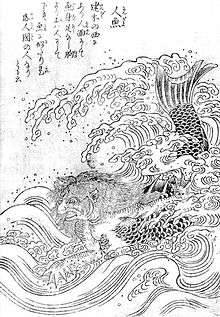Ningyo
Ningyo (人魚, "human fish", often translated as "mermaid") is a fish-like creature from Japanese folklore.

Mythology
Anciently, it was described with a monkey's mouth with small teeth like a fish's, shining golden scales, and a quiet voice like a skylark or a flute. Its flesh is pleasant-tasting, and anyone who eats it will attain remarkable longevity. However, catching a ningyo was believed to bring storms and misfortune, so fishermen who caught these creatures were said to throw them back into the sea. A ningyo washed onto the beach was an omen of war or calamity.
Yao Bikuni
One of the most famous folk stories concerning ningyo is called Yao Bikuni (八百比丘尼, "eight-hundred (years) Buddhist priestess") or Happyaku Bikuni. The story tells how a fisherman who lived in Wakasa Province once caught an unusual fish. In all his years fishing, he had never seen anything like it, so he invited his friends over to sample its meat.
One of the guests, however, peeked into the kitchen, noticed that the head of this fish had a human face, and warned the others not to eat it. So when the fisherman finished cooking and offered his guests the ningyo's grilled flesh, they secretly wrapped it in paper and hid it on their persons so that it could be discarded on the way home.
But one man, drunk on sake, forgot to throw the strange fish away. This man had a little daughter, who demanded a present when her father arrived home, and he carelessly gave her the fish. Coming to his senses, the father tried to stop her from eating it, fearing she would be poisoned, but he was too late and she finished it all. But as nothing particularly bad seemed to happen to the girl afterwards, the man did not worry about it for long.
Years passed, and the girl grew up and was married. But after that she did not age any more; she kept the same youthful appearance while her husband grew old and died. After many years of perpetual youth and being widowed again and again, the woman became a nun and wandered through various countries. Finally she returned to her hometown in Wakasa, where she ended her life at an age of 800 years.
In popular culture
- Fishmen (魚人, Gyojin), often incorrectly referred to as Mermen, are a race who appear throughout the entire anime/manga series of One Piece on a regular basis. They look like humans with fish features and are obviously inspired by the ningyo. Fishman is written like ningyo but with the characters switched (人魚, Ningyo -> 魚人, Gyojin). Merfolk (人魚, Ningyo) appear in the series too. These are more peaceful of nature than the Fishmen and, like the mermaids and mermen of folklore, their upper half is that of a human while the lower half is that of a fish, though male Merfolk are somewhat uncommon.
- The manga/anime series Mermaid Saga by Rumiko Takahashi is based on the Yao Bikuni myth, in which the main characters become immortal by consuming the flesh of a mermaid.
- There is a fake "ningyo" in the National Museum of Ethnology.[1][2]
- The character Serilly from the Puyo Puyo series of games is a lonely ningyo who desires to make friends, but is often paranoid that everyone who approaches her wants to eat her.
- In Okinawa, people have believed that eating ningyo would be unlucky. They also do not eat dugong.
- The character "Ponyo" in the film of the same name is a ningyo or "human-faced fish".
- The primary antagonist of the video game Siren is based on the character Yao Bikuni, and the background of the story is loosely based on the Yao Bikuni legend.
- One of the "monsters of the day" in Tensou Sentai Goseiger is "Jogon of the Ningyo".
- The CCG and roleplaying game Legend of the Five Rings has ningyo characters as members of the Mantis Clan.
- The video game Mermaid Swamp is based on the myth of Yao Bikuni and the ningyo myth.
- A host of ningyo characters feature prominently in the manga and anime series Namiuchigiwa no Muromi-san.
- In Yo-kai Watch, Ningyo appears where its English dub name is Mermaidyn. She is depicted as a mermaid who is constantly caught on the hook of Nate Adams' fishing pole much to his annoyance. Yao Bikuni also appears as Mermadonna, who is Mermaidyn's evolved form.
- Bikuni appears in the anime Konohana Kitan as a secondary character.
- The film Lu over the Wall revolves around an idiosyncratic interpretation of ningyo in which they are a form of undead.
- Yaobikuni is a playable character in the mobile RPG Onmyōji.
- Yaobikuni is a character in the manga series Blade of the Immortal.
- Meimaid, a short film on September 21, 1964. In a fictional place where using the imagination is banned, a boy saves a fish, which surprises everyone by turning into a mermaid and playing with her. The boy is arrested for imagining this "nonsense", and is robbed of his imagination as punishment. However, he regains this ability and turns himself into a mermaid, so they happily leave forever that totalitarian society to live their eternal love alone in the deep abyss.
- In episode 15 of Vampire Princess Miyu the action presents a ningyo and a Yao Bikuni as well, where the protagonist (a Vampire) kills the ningyo which is discovered to be a Shinma. The protagonist ignores Yao Bikuni's plea to make her live eternal happy dreams until the end of her life and instead lets her live the next 100 years to experience human suffering.
Notes
- 民族学者の仕事場: Vol.4 近藤雅樹 Archived 2009-08-22 at the Wayback Machine
- 驚異の伝承と新説 トンでも不思議発見 VOL.1「ミイラの謎が明かされた?!」
See also
References
- Mizuki, Shigeru (2004). Mujara 5. Japan: Soft Garage. p. 49. ISBN 978-4-86133-027-8.
- Mizuki, Shigeru (2001). Mizuki Shigeru No Nihon Yōkai Meguri. Japan: JTB. pp. 90–91. ISBN 978-4-533-03956-0.